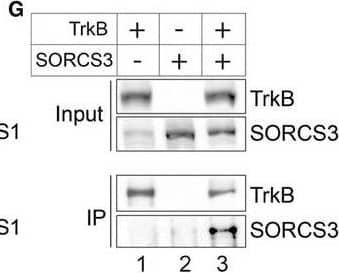Human/Mouse SorCS3 Antibody
R&D Systems, part of Bio-Techne | Catalog # MAB3067

Key Product Details
Species Reactivity
Validated:
Human, Mouse
Cited:
Mouse
Applications
Validated:
Western Blot
Cited:
Western Blot
Label
Unconjugated
Antibody Source
Monoclonal Rat IgG2A Clone # 339624
Product Specifications
Immunogen
Mouse myeloma cell line NS0-derived recombinant mouse SorCS3
Ala131-Ser1122
Accession # Q8VI51
Ala131-Ser1122
Accession # Q8VI51
Specificity
Detects human and mouse SorCS3 in direct ELISAs and Western blots. In direct ELISAs and Western blots, no cross-reactivity with recombinant human SorCS1 is observed.
Clonality
Monoclonal
Host
Rat
Isotype
IgG2A
Scientific Data Images for Human/Mouse SorCS3 Antibody
Detection of Chinese hamster SorCS3 by Western Blot
Altered subcellular localization of TrkB in primary neurons and brains from S1/3 KO miceAWorkflow of the cell surface proteome analysis in primary neurons.BResults of quantitative label‐free proteomics comparing the surface proteomes of WT and S1/3 KO primary cortical neurons. Plot represents –log10(P‐value) and log2 (relative levels S1/3KO/WT) obtained for each protein. For proteins that were detected in either S1/3 KO or WT samples only, the log2(S1/3 KO/WT) was set to 10 or ‐10, respectively. Threshold values are 1.3 for –log10(P‐value) and ±0.3 for log2(S1/3 KO/WT). Proteins showing higher (green) or lower (red) surface levels in S1/3 KO as compared to WT neurons are indicated. Proteins with unchanged cell surface levels are indicated in blue. n = 3 biological replicates/group (with each biological replicate run in two technical replicates).CScheme of brain membrane fractionation used to analyze subcellular localization of TrkB in vivo (see method section for details).DRepresentative Western blotting of TrkB in various brain membrane fractions obtained as described in panel (C). Highlighted lanes represent P3 and P2 fractions, quantified in (E). Detection of PSD95, synaptophysin, and Golgin 97 was used to assess the accuracy of subcellular fractionation.EQuantification of total TrkB distribution between P3 (light membrane fraction) and P2 (synaptosomal fraction) from Western blots exemplified in panel (D) (n = 5 mice/group, 7–12 weeks of age). The TrkB pool is shifted toward the light membrane (P3) fraction in S1/3 KO brains. Data are shown as mean ± SEM and analyzed using two‐way ANOVA with Bonferroni post‐test. ****P < 0.0001.F, GCo‐immunoprecipitation of SORCS1 and SORCS3 with TrkB. TrkB was immunoprecipitated from transiently transfected Chinese hamster ovary cells and the presence of SORCS1 or SORCS3 in the immunoprecipitates documented by Western blotting. Panel input shows levels of the indicated proteins in the cell lysates prior to immunoprecipitation. Panel IP documents co‐immunoprecipitation of SORCS1 (F) and SORCS3 (G) from cells expressing (lanes 3) but not from cells lacking TrkB (lanes 2). The experiment was replicated twice.Source data are available online for this figure. Image collected and cropped by CiteAb from the following publication (https://pubmed.ncbi.nlm.nih.gov/29440124), licensed under a CC-BY license. Not internally tested by R&D Systems.Applications for Human/Mouse SorCS3 Antibody
Application
Recommended Usage
Western Blot
1 µg/mL
Sample: Recombinant Human SorCS3 (Catalog # 3326-SR)
Recombinant Mouse SorCS3 (Catalog # 3067-SR)
Sample: Recombinant Human SorCS3 (Catalog # 3326-SR)
Recombinant Mouse SorCS3 (Catalog # 3067-SR)
Formulation, Preparation, and Storage
Purification
Protein A or G purified from hybridoma culture supernatant
Reconstitution
Reconstitute at 0.5 mg/mL in sterile PBS. For liquid material, refer to CoA for concentration.
Formulation
Lyophilized from a 0.2 μm filtered solution in PBS with Trehalose. *Small pack size (SP) is supplied either lyophilized or as a 0.2 µm filtered solution in PBS.
Shipping
Lyophilized product is shipped at ambient temperature. Liquid small pack size (-SP) is shipped with polar packs. Upon receipt, store immediately at the temperature recommended below.
Stability & Storage
Use a manual defrost freezer and avoid repeated freeze-thaw cycles.
- 12 months from date of receipt, -20 to -70 °C as supplied.
- 1 month, 2 to 8 °C under sterile conditions after reconstitution.
- 6 months, -20 to -70 °C under sterile conditions after reconstitution.
Background: SorCS3
References
- Hermey, G. et al. (2004) J. Neurochem. 88:1470.
- Hampe, W. et al. (2001) Hum. Genet. 108:529.
- Westergaard, U. B. et al. (2005) FEBS Lett. 579:1172.
- Hermey, G. et al. (2006) Biochem. J. 395:285.
- Westergaard, U. et al. (2004) J. Biol. Chem. 279:50221.
Long Name
Sortilin-related VPS10 Domain Containing Receptor 3
Alternate Names
6330404A12Rik, KIAA1059SORCS, sortilin-related VPS10 domain containing receptor 3, VPS10 domain receptor protein SORCS 3 (SORCS3), VPS10 domain-containing receptor SorCS3
Gene Symbol
SORCS3
UniProt
Additional SorCS3 Products
Product Documents for Human/Mouse SorCS3 Antibody
Product Specific Notices for Human/Mouse SorCS3 Antibody
For research use only
